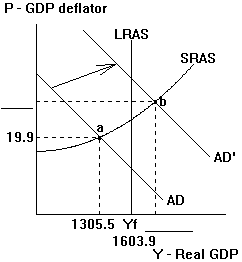| Jim Whitney |
Economics 101 |
Macroeconomic Shocks and the Self-Correction Mechanism: The
Korean War Years
In the early 1950s, the U.S. involvement in the Korean War led to a
positive aggregate demand shock to the U.S. macroeconomy. The diagram below
depicts the initial effects of the shock.

| Year |
RGDP
(1987$) |
GDP Deflator (1987=100) |
Potential RGDP
(1987$) |
Unemployment Rate
(percent) |
| 1949 |
1305.5 |
19.9 |
1603.9 |
5.9 |
| 1953 |
1685.5 |
22.0 |
2.8 |
| 1954 |
1673.8 |
22.2 |
5.4 |
a. Exercise 1: The initial equilibrium in 1949:
Point ____ in the diagram above shows the macroeconomy in an initial short-run
equilibrium, with a GDP deflator of ______ and an actual real GDP of ______,
which falls short of full-employment real GDP of ______. The table also
shows that the unemployment rate in 1949 was _____, but this cannot be
illustrated in the diagram.
b. Exercise 2: The impact of the extra government
demand for goods and services because of the Korean War: AD shifts to AD'.
Before recording the actual data for 1953, use the AD/AS macro model to
predict whether each of the following should rise (+), fall (-), remain
the same (0) or change in an uncertain direction (?): real GDP: ____; the
GDP deflator: ____; the unemployment rate: ____. Now enter the data for
1953 into the diagram above. Did the macro model correctly predict the
directions of the changes in real GDP, the GDP deflator and the unemployment
rate? ______
c. Exercise 3: Self correction: Locate the inflationary
gap that the AD shock creates. How large is it? ______ Because of the inflationary
gap and the resulting excess demand for resources, resource prices will
______, shifting the SRAS curve ______. Show this shift in your diagram
and use the shift to predict whether each of the following should rise
(+), fall (-), remain the same (0) or change in an uncertain direction
(?) after 1953: real GDP: ____; the GDP deflator: ____; the unemployment
rate: ____. Do not plot the 1954 data in the diagram, but look it
over and compare it to the 1953 data. Did the self-correction mechanism
correctly predict the directions of the changes in real GDP, the GDP deflator
and the unemployment rate? ______
d. Exercise 4: Write an overall assessment of the
accuracy of the AD/AS macro model and the self-correction mechanism.
Macroeconomic Shocks and the Self-Correction Mechanism: The
Korean War Years
In the early 1950s, the U.S. involvement in the Korean War led to a
positive aggregate demand shock to the U.S. macroeconomy. This exercise
compares the predicted and actual results.
The Data
| Year |
RGDP
(1987$) |
GDP Deflator (1987=100) |
Potential RGDP
(1987$) |
Unemployment Rate
(percent) |
| 1949 |
1305.5 |
19.9 |
1603.9 |
5.9 |
| 1953 |
1685.5 |
22.0 |
2.8 |
| 1954 |
1673.8 |
22.2 |
5.4 |
Macroeconomic Shocks and the Self-Correction Mechanism: The
Korean War Years
In the early 1950s, the U.S. involvement in the Korean War led to a
positive aggregate demand shock to the U.S. macroeconomy. This exercise
compares the predicted and actual results.
The Diagram

Names: ________________________ ________________________
________________________ ________________________
Macroeconomic Shocks and the Self-Correction Mechanism:
The Korean War Years
In the early 1950s, the U.S. involvement in the Korean War led to a positive
aggregate demand shock to the U.S. macroeconomy. This exercise compares
the predicted and actual results.
Actual versus predicted results
a. Exercise 1: The initial equilibrium in 1949: Point
____ in the diagram above shows the macroeconomy in an initial short-run
equilibrium, with a GDP deflator of ______ and an actual real GDP of ______,
which falls short of full-employment real GDP of ______. The table also
shows that the unemployment rate in 1949 was _____, but this cannot be
illustrated in the diagram.
b. Exercise 2: The impact of the extra government
demand for goods and services because of the Korean War: AD shifts to AD'.
Before recording the actual data for 1953, use the AD/AS macro model to
predict whether each of the following should rise (+), fall (-), remain
the same (0) or change in an uncertain direction (?): real GDP: ____; the
GDP deflator: ____; the unemployment rate: ____. Now enter the data for
1953 into the diagram above. Did the macro model correctly predict the
directions of the changes in real GDP, the GDP deflator and the unemployment
rate? ______
c. Exercise 3: Self correction: Locate the inflationary
gap that the AD shock creates. How large is it? ______ Because of the inflationary
gap and the resulting excess demand for resources, resource prices will
______, shifting the SRAS curve ______. Show this shift in your diagram
and use the shift to predict whether each of the following should rise
(+), fall (-), remain the same (0) or change in an uncertain direction
(?) after 1953: real GDP: ____; the GDP deflator: ____; the unemployment
rate: ____. Do not plot the 1954 data in the diagram, but look it
over and compare it to the 1953 data. Did the self-correction mechanism
correctly predict the directions of the changes in real GDP, the GDP deflator
and the unemployment rate? ______
d. Exercise 4: Write an overall assessment of the
accuracy of the AD/AS macro model and the self-correction mechanism.


